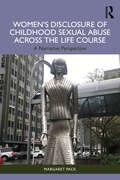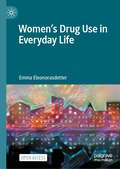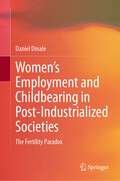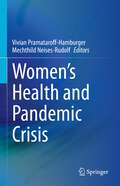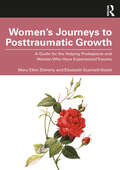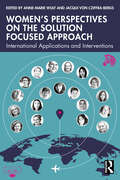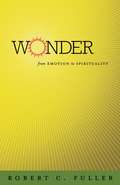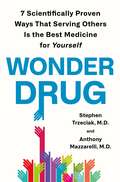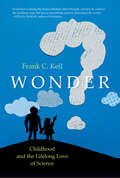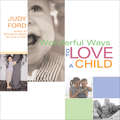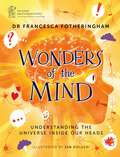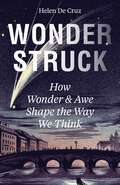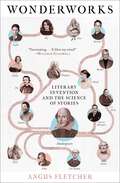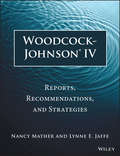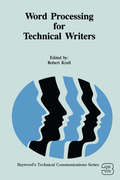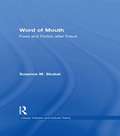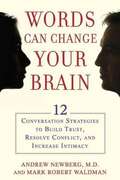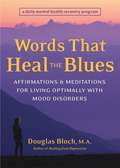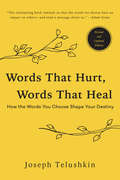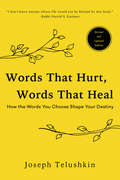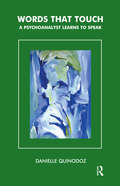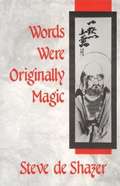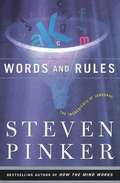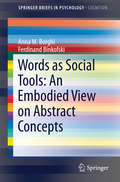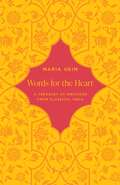- Table View
- List View
Women’s Disclosure of Childhood Sexual Abuse Across the Life Course: A Narrative Perspective
by Margaret PackTaking a narrative approach, this book explores the role of disclosure in sexual abuse recovery for women survivors of child sexual abuse.Drawing on longitudinal research with sexual abuse therapists and de-identified cases drawn from her clinical practice, Pack emphasises the unique value of both a narrative and life course approach to the topic of sexual abuse recovery. The book explores the ages and stages of life as triggering new challenges to adapt to for adult women survivors, evoking the need to develop new ways of acting and being in the world. Conceptualising disclosure as a process that occurs in relationship with the person disclosed to, it highlights the importance of the quality of the relationship between the survivor and the person confided in and previous disclosure attempts. Further, the chapters outline individual, contextual and environmental factors that impede or facilitate disclosure, as well as different verbal and non-verbal forms that disclosure can take.With a focus on the Australasian context, this book is a resourceful guide for mental health professionals and practitioners who work in the field of sexual abuse recovery, as well as those who work with women in refuge situations and other health and wellbeing services.
Women’s Drug Use in Everyday Life
by Emma EleonorasdotterThis open access book explores the increasing role of psychoactive substances in contemporary everyday life, focussing on women's use. Drawing on an ethnographic study in Sweden, it uses cultural studies and queer phenomenology to analyse the women’s narratives of drug use relating to themes that encompass social, legal, cultural, embodied and gendered perspectives on drugs in the contemporary Western world. It examines topics such as stigma, happiness, children, the body, gifts, the drug market, medication, sickness and health and also the orientation of themselves towards others, to social and cultural norms, to drug laws and to the substances. It discusses how drug related spaces and directions be analysed in terms of gender and class, and how, in turn, the directions of contemporary society and culture can be affected by drug use. It speaks to academics in Sociology, Criminology, Ethnology, Gender studies, Law and History.
Women’s Employment and Childbearing in Post-Industrialized Societies: The Fertility Paradox
by Daniel DinaleThis book discusses the relationship between women's labour force participation and fertility rates in developed nations. It shows a positive relationship between women's workforce participation and childbirth. It theorises a new approach to explaining this 'fertility paradox' that looks at institutional factors influencing gender equality in developed nations. The book analyses a range of institutional variables that impact the positive relationship between female employment and fertility rates, including labour market institutions, social policies and welfare state institutions (family policies, active labour market programs and public sector employment) as well as household gender dynamics. Written for both academics and policy-makers, this book has theoretical relevance for research on gender and work, and also for policies aimed at increasing women's employment and redressing low fertility, which are important issues in many developed nations.
Women’s Health and Pandemic Crisis
by Vivian Pramataroff-Hamburger Mechthild Neises-RudolfThis book focuses on the unique challenges for women in a pandemic situation, both as caretakers and patients. It has been noted that in the last two years medical doctors, psychologists, and health workers have seen a huge impact of the pandemic experience on women and their families. Children and adolescents suffered from a strong reduction of social contacts, while families had often to resort to cramped living condition that put a strain on normal life activities, especially in underprivileged areas of society. Fear and uncertainty reigned. All these factors caused a wide range of psychosocial symptoms, from loneliness to domestic violence, depression, and psychosomatic reactions. As health professionals, women have been influenced by the pandemic experience as well. Hospital staff, who had to care for a huge number of seriously ill patients in a very short time, were confronted with considerable expectations, which often turned into hostility, especially in the period before vaccinations became available. Psychotherapists received increased requests for appointments and had to adjust to video consultation for those they were able to accommodate in their practice.Seeing the pandemic crisis as an opportunity to learn from mistakes, and lack of preparation, fostering a greater understanding of women’s health in general, and the unique experiences of pregnancy, childbirth, trauma, adolescence, body experience, and gender identity that affects their health. This book gathers our current state of knowledge about women in the extreme situation of a pandemic crisis and points the way to an improved level of care for the future.“This timely view of women’s mental health in pandemics provides a vision to the path we must all take now to assist women in some of the most important elements of preventive care: their mental and emotional well-being … [T]his book emphasizes that the mental health of a mother must be considered in all circumstances. Well done for being the conscience we need!”- Jeanne Ann Conry, MD, PhD, President, The International Federation of Gynecology and Obstetrics, Past President, The American College of Obstetricians and Gynecologists, Immediate Past Chair, The Women’s Preventive Health Initiative (WPSI)
Women’s Journeys to Posttraumatic Growth: A Guide for the Helping Professions and Women Who Have Experienced Trauma
by Mary Ellen Doherty Elizabeth Scannell-DeschThis accessible book draws on research around women’s experiences to illustrate and explore the concept of posttraumatic growth, emphasizing practice implications for healthcare professionals and strategies for fostering posttraumatic growth. Including the voices of women, in their own words, Women’s Journeys to Posttraumatic Growth explains the differences between post-traumatic stress disorder and posttraumatic growth and presents the theoretical framework of posttraumatic growth. It synthesizes relevant international research and introduces data from four new qualitative research studies on posttraumatic growth in women who have experienced the death of a spouse or longtime partner, death of a child, a close brush with death, and intimate partner abuse. The book develops clinical and nursing practice implications for healthcare professionals and explores current self-help and professional therapeutic strategies to foster posttraumatic growth. Women’s Journeys to Posttraumatic Growth is an invaluable guide for health and social care practitioners, as well as students and researchers with an interest in trauma, abuse, bereavement and loss, and women’s healthcare.
Women’s Perspectives on the Solution Focused Approach: International Applications and Interventions
by Anne-Marie Wulf Cziffra-Bergs, Jacqui vonThis book is a distinctive collection of narratives of female Solution Focused practitioners, from across six continents, sharing their unique ways of using the approach at personal, professional, and social levels.Nineteen female practitioners from around the world share their practice and experience, and reflect on how their gender has influenced their work within different cultural, sociological, and socio-economic contexts. The editors introduce the concepts of a Solution Focused DNA and then encourage the contributors as well as the readers to answer questions such as: What are the common characteristics that are a part of your Solution Focused DNA? Which of them are related to gender, Which of them to the Solution Focused Approach, and Which of them to your sociocultural context? Contributors also provide insights on how they work from the Solution Focused approach integrating their own creative styles using embodiment and dance, animal assisted therapy, and humour. The chapters in this book explore a wide variety of themes and contexts, including shelters, trauma, the LGBTQ community, prisons, schools, refugee camps, veterans, the medical field, research, children, and more.This book will inspire practitioners regardless of gender to reflect on their own practice and to use and apply the Solution Focused Approach in innovative and creative ways.
Wonder
by Robert C. FullerThe attempt to identify the emotional sources of religion goes back to antiquity. In an exploration that bridges science and spirituality, Robert C. Fuller makes the convincing case that a sense of wonder is a principal source of humanity's belief in the existence of an unseen order of life. Like no other emotion, Fuller argues, wonder prompts us to pause, admire, and open our hearts and minds.With a voice that seamlessly blends the scientific and the contemplative, Fuller defines wonder in keeping with the tradition of Socrates--as an emotion related to curiosity and awe that stimulates engagement with the immediate physical world. He draws on the natural and social sciences to explain how wonder can, at the same time, elicit belief in the existence of a more-than-physical reality. Chapters examining emotions in evolutionary biology and the importance of wonder in human cognitive development alternate with chapters on John Muir, William James, and Rachel Carson, whom Fuller identifies as "exemplars of wonder." The writings and lives of these individuals express a functional side of emotion: that the very survival of life on earth today may depend on the empathy, compassion, and care that are aroused by a sense of wonder.Forging new pathways between the social sciences, philosophy, belief, and cultural history, Wonder deepens our understanding of the complex sources of personal spirituality and fulfillment.Bridging science and spirituality, Robert Fuller makes the convincing case that a sense of wonder is a principal source of humanity's belief in the existence of an unseen order of life. Like no other emotion, he argues, wonder prompts us to pause, admire, and open our hearts and minds. Chapters examining emotions in evolutionary biology and the importance of wonder in human cognitive development alternate with chapters on John Muir, William James, and Rachel Carson, whom Fuller identifies as "exemplars of wonder." The writings and lives of these individuals express a functional side of emotion: that the very survival of life on earth today may depend on the empathy, compassion, and care that are aroused by a sense of wonder.-->
Wonder Drug: 7 Scientifically Proven Ways That Serving Others Is the Best Medicine for Yourself
by Stephen Trzeciak M.D. Anthony Mazzarelli M.D.A pair of doctors team up to illuminate, through neuroscience and captivating stories from their clinical practice, how serving others—and pitching in to the world in general—is a secret superpower.If a doctor’s prescription could bring you:- Longer life- Better health- More energy and resilience- Less burnout, depression and anxiety- More happiness, fulfillment and well-being- More personal and professional success (including higher income)- And, no harmful side effectsWould you take it? In Wonder Drug, physician scientists Stephen Trzeciak, M.D., and Anthony Mazzarelli, M.D., illuminate, through neuroscience and captivating stories from their clinical practices, how being a giving, other-focused person is a secret superpower. Serving others—and pitching in to the world in general—is the evidence-based way to live your life. Kinder people not only live longer, they also live better. Science shows that serving others is not just the right thing to do, it’s also the smart thing to do. Wonder Drug will make you rethink your notions of “self-care” and “me time,” and realize that focusing on others is a potent antidote to the weariness that so many of us feel in modern times. Getting outside of your own head, outside the swirl of self-concern that may dominate your mental chatter, is, ironically, one of the best things you can do for yourself. Building upon their earlier work showing that, in the context of healthcare, having more compassion for patients is a powerful way to not only achieve better patient outcomes, but also promote well-being, resilience and resistance to burnout among healthcare workers, Trzeciak and Mazzarelli now extend their research to uncover how the power of serving others reaches far beyond the medical world and can be a life-changing therapy for everyone. Wonder Drug relates to the varying meanings of giving in real people’s daily lives. The stories in this book will convince and inspire you to make simple prism changes. You don’t need a total life upheaval, just a purposeful shift in mindset. In fact, the crucial first piece of the evidence-based prescription is this: start small. Per science, the best way to well-being and finding your true fulfillment is this: scan your orbit for the people around you in need of help, and go fill that need, as often as you can.
Wonder: Childhood and the Lifelong Love of Science
by Frank C. KeilHow we can all be lifelong wonderers: restoring the sense of joy in discovery we felt as children.From an early age, children pepper adults with questions that ask why and how: Why do balloons float? How do plants grow from seeds? Why do birds have feathers? Young children have a powerful drive to learn about their world, wanting to know not just what something is but also how it got to be that way and how it works. Most adults, on the other hand, have little curiosity about whys and hows; we might unlock a door, for example, or boil an egg, with no idea of what happens to make such a thing possible. How can grown-ups recapture a child&’s sense of wonder at the world? In this book, Frank Keil describes the cognitive dispositions that set children on their paths of discovery and explains how we can all become lifelong wonderers. Keil describes recent research on children&’s minds that reveals an extraordinary set of emerging abilities that underpin their joy of discovery—their need to learn not just the facts but the underlying causal patterns at the very heart of science. This glorious sense of wonder, however, is stifled, beginning in elementary school. Later, with little interest in causal mechanisms, and motivated by intellectual blind spots, as adults we become vulnerable to misinformation and manipulation—ready to believe things that aren&’t true. Of course, the polymaths among us have retained their sense of wonder, and Keil explains the habits of mind and ways of wondering that allow them—and can enable us—to experience the joy of asking why and how.
Wonderful Ways to Love a Child: Even When It Seems Impossible (Wonderful Ways)
by Judy FordA Powerful Lesson on Unconditional Love and How to Raise Happy ChildrenThis collection of essays offers a gentle guide on how to put a parent's love into daily actions. A parent’s calling is to raise a person. By making loving actions part of your life, you have the power to build the kind of family unit most people long for. Wonderful Ways to Love a Child is filled with true stories of parents and children who are nurturing strong and loving families. The book provides the support that empowers you to be the parent you want to be and expands your parenting skills.No simple tricks. Cultivating a loving relationship with your child demands integrity, compassion, and emotional honesty. It is a forever commitment to continuous loving actions–even when you are too tired. This low-stress approach to positive parenting produces happy children with high self-esteem. This is how children succeed.A perfect gift for new parents. Wonderful Ways to Love a Child is a prescription to strengthen family bonds that will last a lifetime. There are many different parenting styles–this one is based in love and logic, and positive discipline. Learn to put yourselves in your children’s shoes–and have fun in the process.In this book you’ll discover guides to:Loving yourself and allowing your child to love themselvesGiving the gift of your presence and being open to the miracle of transformationSaying yes as often as possible, and knowing when to say noTeaching that all feelings are acceptable and making room for the CrankiesDelighting in silliness by laughing, dancing and singing togetherTeaching values by exampleOther essential tools to ensure a loving, lasting friendship with your children–and make them want to come visit when they are olderIf you enjoyed parenting books such as How to Talk so Kids Will Listen and How to Listen so Kids Will Talk, 1-2-3 Magic, or Parenting with Love and Logic, you’ll love Wonderful Ways to Love a Child.
Wonders of the Mind: Understanding the universe inside our heads
by Dr Francesca FotheringhamExplore the many pathways of the mind in this beautiful celebration of brain power and neurodiversity, written by developmental psychologist, Dr. Francesca Fotheringham and published in association with The British Psychological Society.Wonders of the Mind is a beautiful and powerful look at the workings of the brain and the complexity of the mind. Explore the chemical messages that guide our bodies, the changes brains and minds undergo as they grow, our emotions, memories and the power of sleep. Enhance your understanding of both neurodiversity and mental health through clear and sensitive introductions to each topic. Consider the influence of physical health, culture and language on the mind - and try out some brain teasers to see it all in action! Perfect for readers aged 9 and up.This is the fourth book in a series published by Wayland and illustrated by Jan Bielecki that take an authoritative look at the wonders of science - making complex ideas accessible to kids. Other books in the series include: Wonders of the Night Sky and The Future of the Universe by Professor Raman Prinja and The Wonders of Time, by Emily Akkermans, which were published in association with Royal Observatory Greenwich.
Wonderstruck: How Wonder and Awe Shape the Way We Think
by Helen De CruzA philosopher explores the transformative role of wonder and awe in an uncertain worldWonder and awe lie at the heart of life&’s most profound questions. Wonderstruck shows how these emotions respond to our fundamental need to make sense of ourselves and everything around us, and how they enable us to engage with the world as if we are experiencing it for the first time.Drawing on the latest psychological insights on emotions, Helen De Cruz argues that wonder and awe are emotional drives that motivate us to inquire and discover new things, and that humanity has deliberately nurtured these emotions in cultural domains such as religion, science, and magic. Tracing how wonder and awe unify philosophy, the humanities, and the sciences, De Cruz provides new perspectives on figures such as Plato, Aristotle, Adam Smith, William James, Rachel Carson, Maurice Merleau-Ponty, Jean-Paul Sartre, and Abraham Heschel. Along the way, she explains how these singular emotions empower us to be open-minded, to experience joy and hope, and to be resilient in the face of personal troubles and global challenges.Taking inspiration from Descartes&’s portrayal of wonder as &“that sudden surprise of the soul,&” this illuminating book reveals how wonder and awe are catalysts that can help us reclaim what makes life worth living and preserve the things we find wonderful and valuable in our lives.
Wonderworks: The 25 Most Powerful Inventions in the History of Literature
by Angus FletcherThis &“fascinating&” (Malcolm Gladwell, New York Times bestselling author of Outliers) examination of literary inventions through the ages, from ancient Mesopotamia to Elena Ferrante, shows how writers have created technical breakthroughs—rivaling scientific inventions—and engineering enhancements to the human heart and mind.Literature is a technology like any other. And the writers we revere—from Homer, Shakespeare, Austen, and others—each made a unique technical breakthrough that can be viewed as both a narrative and neuroscientific advancement. Literature&’s great invention was to address problems we could not solve: not how to start a fire or build a boat, but how to live and love; how to maintain courage in the face of death; how to account for the fact that we exist at all. Wonderworks reviews the blueprints for twenty-five of the most significant developments in the history of literature. These inventions can be scientifically shown to alleviate grief, trauma, loneliness, anxiety, numbness, depression, pessimism, and ennui, while sparking creativity, courage, love, empathy, hope, joy, and positive change. They can be found throughout literature—from ancient Chinese lyrics to Shakespeare&’s plays, poetry to nursery rhymes and fairy tales, and crime novels to slave narratives. A &“refreshing and remarkable&” (Jay Parini, author of Borges and Me: An Encounter) exploration of the new literary field of story science, Wonderworks teaches you everything you wish you learned in your English class, and &“contains many instances of critical insight....What&’s most interesting about this compendium is its understanding of imaginative representation as a technology&” (The New York Times).
Woodcock-Johnson IV: Reports, Recommendations, and Strategies
by Nancy Mather Lynne E. JaffeIncludes online access to new, customizable WJ IV score tables, graphs, and forms for clinicians Woodcock-Johnson IV: Reports, Recommendations, and Strategies offers psychologists, clinicians, and educators an essential resource for preparing and writing psychological and educational reports after administering the Woodcock-Johnson IV. Written by Drs. Nancy Mather and Lynne E. Jaffe, this text enhances comprehension and use of this instrument and its many interpretive features. This book offers helpful information for understanding and using the WJ IV scores, provides tips to facilitate interpretation of test results, and includes sample diagnostic reports of students with various educational needs from kindergarten to the postsecondary level. The book also provides a wide variety of recommendations for cognitive abilities; oral language; and the achievement areas of reading, written language, and mathematics. It also provides guidelines for evaluators and recommendations focused on special populations, such as sensory impairments, autism, English Language Learners, and gifted and twice exceptional students, as well as recommendations for the use of assistive technology. The final section provides descriptions of the academic and behavioral strategies mentioned in the reports and recommendations. The unique access code included with each book allows access to downloadable, easy-to-customize score tables, graphs, and forms. This essential guide Facilitates the use and interpretation of the WJ IV Tests of Cognitive Abilities, Tests of Oral Language, and Tests of Achievement Explains scores and various interpretive features Offers a variety of types of diagnostic reports Provides a wide variety of educational recommendations and evidence-based strategies
Word Processing for Technical Writers (Baywood's Technical Communications Ser.)
by Robert KrullSupports the idea of matching the "system" to the technical writer's needs. This book contains numerous questions and answers.
Word of Mouth: Food and Fiction After Freud (Literary Criticism and Cultural Theory)
by Susanne M. SkubalFirst Published in 2002. Routledge is an imprint of Taylor & Francis, an informa company.
Words Can Change Your Brain: 12 Conversation Strategies to Build Trust, Resolve Conflict, and Increase Intimacy
by Andrew Newberg Mark Robert WaldmanIn our default state, our brains constantly get in the way of effective communication. They are lazy, angry, immature, and distracted. They can make a difficult conversation impossible. But Andrew Newberg, M.D., and Mark Waldman have discovered a powerful strategy called Compassionate Communication that allows two brains to work together as one.<P><P> Using brainscans as well as data collected from workshops given to MBA students at Loyola Marymount University, and clinical data from both couples in therapy and organizations helping caregivers cope with patient suffering, Newberg and Waldman have seen that Compassionate Communication can reposition a difficult conversation to lead to a satisfying conclusion. <P>Whether you are negotiating with your boss or your spouse, the brain works the same way and responds to the same cues. The truth, though, is that you don't have to understand how Compassionate Communication works. You just have to do it. Some of the simple and effective takeaways in this book include: * Make sure you are relaxed; yawning several times before (not during) the meeting will do the trick * Never speak for more than 20-30 seconds at a time. After that they other person's window of attention closes. * Use positive speech; you will need at least three positives to overcome the effect of every negative used * Speak slowly; pause between words. This is critical, but really hard to do. * Respond to the other person; do not shift the conversation. * Remember that the brain can only hold onto about four ideas at one time Highly effective across a wide range of settings, Compassionate Communication is an excellent tool for conflict resolution but also for simply getting your point across or delivering difficult news.
Words That Heal the Blues: Affirmations and Meditations for Living Optimally with Mood Disorders
by Douglas Bloch"Affirmations (positive self-statements) are a simple and time-proven way of redirecting the mind to accentuate the positive. When you turn your mind to something positive and life affirming, the negative has no place in your mind to dwell. It's as if the neurons literally light up a different pathway or circuit in the brain. The repetition of affirmations over time will change negative, fear-producing thoughts into positive, uplifting ones, thereby leading to a change in mood." -from the IntroductionEvery thought produces a neurochemical reaction that in turn affects the way we feel. With this in mind, author and counselor Douglas Bloch developed a daily program of self-care strategies to enhance one's mood. Based on his best-selling book WORDS THAT HEAL, WORDS THAT HEAL THE BLUES uses the power of daily affirmations to alleviate the painful symptoms of depression, anxiety, addiction, and other mood disorders. Each day includes a self-care lesson, a series of affirmations, and an activity to help transform the lesson into positive action. These healing words will comfort and inspire you to let go of fear and worry, and let wellness and harmony into your life, one day at a time. Includes a 30-day program for alleviating depression, anxiety, and negative thoughts and feelings, from the author of HEALING FROM DEPRESSION. According to the Surgeon General, 22 percent of all Americans experience a mental or emotional disorder in any given year, and 50 percent do so in their lifetime. Lessons include "Setting the Intention to Heal," "Letting Go of Worry," "Overcoming the Stigma of Depression," and "Finding Your Purpose." The original Words That Heal sold more than 85,000 copies and has been translated into five languages.From the Trade Paperback edition.
Words That Hurt, Words That Heal, Revised Edition: How the Words You Choose Shape Your Destiny
by Joseph TelushkinFrom the New York Times bestselling author of Rebbe comes this newly revised edition of Words That Hurt, Words That Heal—an invaluable guide in how choosing the right words can enrich our relationships and give us insight to improve every facet of our lives.“I don’t know anyone whose life would not be blessed by this book.”—Rabbi Harold S. Kushner, author of When Bad Things Happen to Good People and Nine Essential Things I’ve Learned About Life Joseph Telushkin is renowned for his warmth, his erudition, and his richly anecdotal insights, and in Words That Hurt, Words That Heal he focuses these gifts on the words we use in public and in private, revealing their tremendous power to shape relationships. With wit and wide-ranging intelligence, Rabbi Telushkin explains the harm in spreading gossip, rumors, or others’ secrets, and how unfair anger, excessive criticism, or lying undermines true communication. By sensitizing us to subtleties of speech we may never have considered before, he shows us how to turn every exchange into an opportunity.In this fully revised edition, Joseph Telushkin brings this classic into the modern age. Remarkable for its clarity and practicality, Words That Hurt, Words That Heal illuminates the powerful effects we create by what we say and how we say it.
Words That Hurt, Words That Heal: How To Choose Words Wisely And Well
by Joseph TelushkinJoseph Telushkin is renowned for his warmth, his erudition, and his richly anecdotal insights, and in Words That Hurt, Words That Heal he focuses these gifts on the words we use in public and in private, revealing their tremendous power to shape relationships. With wit and wide-ranging intelligence, Rabbi Telushkin explains the harm in spreading gossip, rumors, or others' secrets, and how unfair anger, excessive criticism, or lying undermines true communication. By sensitizing us to subtleties of speech we may never have considered before, he shows us how to turn every exchange into an opportunity. Remarkable for its clarity and practicality, Words That Hurt, Words That Heal illuminates the powerful effects we create by what we say and how we say it.
Words That Touch: A Psychoanalyst Learns to Speak
by Danielle QuinodozIn her attempt to find the words that touch, the author gives a succession of illuminating examples to indicate what a psychoanalyst and her patient may experience in the transference relationship during the course of an analysis. On the basis of her clinical experience, the author points out that we all use relatively mature psychic mechanisms and others of a more primitive nature, the former being accessible to symbolism and the latter less so. However, she notes that some can tolerate the awareness of their heterogeneity even if on occasion it causes them pain, while others are rendered so anxious by their lack of inner cohesion that they are afraid of losing their sense of identity. These people particularly need to be touched by words capable of simultaneously evoking fantasies, thoughts, feelings and sensations if they are to be able to unfold their psychic freedom and creativity to the full.
Words Were Originally Magic
by Steve De ShazerIn explicating how language works in therapy, De Shazer ranges widely, citing and critiquing Lacan, Bateson, Ackerman, and Weakland, among others. But the heart of this book can be found in the detailed conversations between client and therapist that show solution-focused therapy in action.
Words and Rules: The Ingredients of Language
by Steven PinkerPinker (psychology, MIT) explains the mysteries of language, such as why languages change over time and how children learn their native language, by dissecting the idea that language comprises a mental dictionary of memorized words and a mental grammar of creative rules. Pinker connects a remarkable number of topics such as the attempts to simulate language using computers; the nature of human concepts; the peculiarities of the English language; and the theories of Noam Chomsky, through a minute dissection of the phenomenon of regular and irregular verbs. Annotation c. Book News, Inc., Portland, OR (booknews.com)
Words as Social Tools: An Embodied View on Abstract Concepts
by Anna M. Borghi Ferdinand BinkofskiHow are abstract concepts and words represented in the brain? That is the central question addressed by the authors of "Words as Social Tools: An Embodied View on Abstract Concepts". First, they focus on the difficulties in defining what abstract concepts and words are, and what they mean in psycholinguistic research. Then the authors go on to describe and critically discuss the main theories on this topic with a special emphasis on the different embodied and grounded theories proposed in cognitive psychology within the last ten years, highlighting the advantages and limitations of each of these theories. The core of this Brief consists of the presentation of a new theory developed by the authors, the WAT (Words As social Tools) view, according to which both sensorimotor (such as perception, action, emotional experiences) and linguistic experiences are at the basis of abstract concepts and of abstract word representation, processing and use. This theory assigns a major role to acquisition: one of the assumptions the authors make is that the different ways in which concrete and abstract words are acquired constrain their brain representation and their use. This view will be compared with the main existing theories on abstractness, from the theory of conceptual metaphors to the theories on multiple representation. Finally, the volume illustrates recent evidence from different areas (developmental, behavioral, cross-cultural, neuropsychological and neural) which converge with and support the authors' theory, leading to the conclusion that in order to account for representation and processing of abstract concepts and words, an extension of embodied and grounded theories is necessary.
Words for the Heart: A Treasury of Emotions from Classical India
by Maria HeimA richly diverse collection of classical Indian terms for expressing the many moods and subtleties of emotional experienceWords for the Heart is a captivating treasury of emotion terms drawn from some of India’s earliest classical languages. Inspired by the traditional Indian genre of a “treasury”—a wordbook or anthology of short texts or poems—this collection features 177 jewel-like entries evoking the kinds of phenomena English speakers have variously referred to as emotions, passions, sentiments, moods, affects, and dispositions. These entries serve as beautiful literary and philosophical vignettes that convey the delightful texture of Indian thought and the sheer multiplicity of conversations about emotions in Indian texts. An indispensable reference, Words for the Heart reveals how Indian ways of interpreting human experience can challenge our assumptions about emotions and enrich our lives.Brings to light a rich lexicon of emotion from ancient IndiaUses the Indian genre of a “treasury,” or wordbook, to explore the contours of classical Indian thought in three of the subcontinent’s earliest languages—Sanskrit, Pali, and PrakritFeatures 177 alphabetical entries, from abhaya (“fearlessness”) to yoga (“the discipline of calm”)Draws on a wealth of literary, religious, and philosophical writings from classical IndiaIncludes synonyms, antonyms, related words, and suggestions for further readingInvites readers to engage in the cross-cultural study of emotionsReveals the many different ways of naming and interpreting human experience
